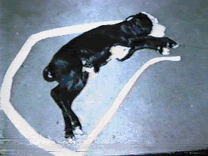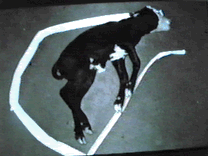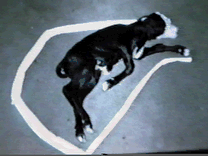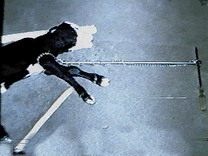|
BASIC
BOVINE OBSTETRICS LABORATORY Goals
|
|
|
|
Click below to view Dr. Ronnie Elmore's KSU images of bovine obstetrics. |
| The normal delivery is made
longitudinal, in the anterior
presentation, dorsal sacral position, with bilateral foreleg extension
(in other words the calf dives out right-side-up, head and front feet
first).
The white outline in all subsequent photos represents the
uterus. |
| The first step in obstetrics is to make sure
the cow is restrained in a safe place for both her and you. Make sure
that if she goes into recumbence, that she can breathe! It always best
to tie the tail out of the way and then wash the vulva (and yourself) before proceeding on with the examination. Always use plenty of
lubrication to make things easier for you, the cow and the calf. Trying to
do things without proper lubrication can make the extraction much more
difficult and tire you out quickly. Commercial lubricants work well, as
does ivory liquid, but soaps can wash away the normal lubricants
provided by the amniotic and chorioallantoic fluids. It is often helpful
to pass a large bore tube into the use and then use a stomach
pump to pump 2 to 3 gallons of lubricant into the uterus and
around the fetus.
Preparation |
| If both front legs and the head are in the
correct position, then you must decide if the calf can pass through the
birth canal. Do this by placing obstetrical chains on the forelegs
(assuming they are forelegs from the same calf..... more about that later),
one loop over the fetlocks and a second half hitch below the fetlocks.
Ideally the chains should come over the top of the fetlocks, not
the sides or bottoms. You may need to use three point traction by placing a head snare behind
the calf's head and in the mouth (the same thing can be done with an OB
chain). With 2 or 3 people (no fetal extractors or John Deere tractors)
pulling, if the fetlocks can be presented a hand's width past the lips of
the vulva, then the calf should come. Remember to rotate the calf about
450 when pulling so the calf is passing through the birth
canal at the maximum diameter of the canal (the canal is oval, not
round).
Position Anterior - 2 point traction Anterior - 3 point traction
|
|
The same type of criterion can be used if the calf is coming backwards (yes, it is OK to pull a calf backwards, as long as it is right side up). If the hocks can be presented outside the vulva with 2 or 3 people pulling, then the calf should come out. It is acceptable to use fetal extractors (calf pullers) if this criterion is followed. If you do not follow these pull-no pull criteria then you will try to pull calves that are too large to fit through the birth canal and end up killing dam and calf. 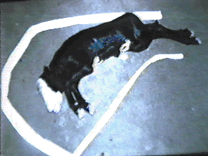
|
| If only feet are presented, then you must decide if they are front or back feet....a seemingly idiotic procedure that is oh.... oh. ...oh so important. Front feet have 4 joints that flex in the same direction (coffin, pastern, fetlock, and carp us) before the elbow goes the opposite direction. The back leg has only 3 joints that flex in the same direction (coffin, pastern, fetlock) before the hock goes in the other direction. This seemingly academic procedure can save you much agony and embarrassment. If the legs are back legs, then pull using the pull-no pull criterion. The tail head may have to be pushed down in order to not engage and stop the delivery. If the legs are front legs, make sure they are from the same calf by tracing them back to the same body. Now you have to find the head. |
|
A lateral head deviation is the most common head postural problem. You can sometimes get the head out by placing your hand under the jaw and pulling (never put your hand inside the mouth as the teeth are very sharp and will cut your hand). The second best way is to put your thumb and forefinger it the eye sockets and pull. To successfully do any OB procedure it is imperative that you repel the calf in order to give yourself more room to carry out your mutations. Repelling the calf while you do manipulations is an extremely important aspect of obstetrics that cannot be overemphasized. If you cannot get the head out manually while repelling, you may have to use eye hooks. Place the hook in the medial canthus of the far eye, repel the calf and pull on the head. Alternatively, a 'chain bridle' can be placed around the calf's head to pull it straight. 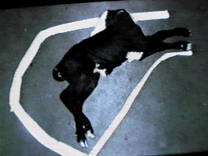
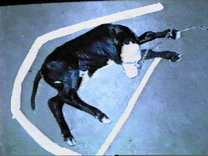
Lateral head deviation |
| If only one or no front feet are presented
then the legs and head must be extended before fetal extraction. If
front feet are to be extended, it is done in 2 steps. First grasp the
leg between the carpus and elbow and pull, next slide down the leg and
grasp it below the fetlock and pull. The same technique can be done
using chains to increase your force. Remember to repel when performing
mutations!
Anterior Presentation |
|
If only the tail is presented, you have a breech presentation. You must cup one hand under the foot (it will scrape the 'wrong way' against the uterus) and push the hock medially and dorsally while pulling on the cupped foot. You can also do this procedure with chains. Posterior Presentation |
| If the calf is upside down, then it must be
rotated right side up before extracting. You may be able to do this
manually by rocking the fetus, but this is difficult. A detortsion bar
makes it much easier. Place a loop on one leg (front or back, whichever
is presented) and slide the chain up as far possible (above the elbows).
Next, place a loop through the hole on the end of the rod and place that
loop over the other leg, again moving it as high up on the leg as
possible. Wrap the chain in the direction you want to turn the calf,
secure the chain in the other hole and rotate. Remember to lubricate the
fetus well, or you can create a uterine torsion (something that you can
also use the distortion rod to do if you are trying to correct a uterine
torsion).
Detorsion |
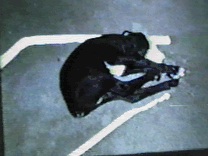 The most complicated, fetal extraction is that of the 'sitting dog' position. This is when all four feet and the head of the calf are presented in the birth canal. It is usually not possible to disengage the rear legs from the birth canal....no matter how hard you try. To correct this condition, place chains on the rear legs and repel the front of the calf back into the uterus. In doing this you will create a posterior presentation in the dorso-pelvic position (backwards and upside down). You now simply use the distortion rod to turn the calf right side up and pull the calf in the posterior presentation. 'Sitting Dog' |
|
IFetotomy If you cannot extract the fetus per vaginum
you can do a caesarian section or a percutaneous fetotomy. A C-section
is the only way to go if the calf is alive, fresh or very large. A
fetotomy is the way to go if the calf is rotten, dead, or you expect you
can get it out with 1 or 2 cuts. Always decide soon, not when you are
exhausted, that you need to do a fetotomy or c-section. The basic rules
of fetotomy, always cut off as much as you can with each cut and never
leave a sharp end. Cutting off a lateral head deviation is very easy and
much faster that a c-section. Always use a two barreled fetotome, not a
mouth speculum. Lateral head deviation fetotomy
Thread the wire through one tube, use a wire passer to pass the
free wire end around the head, thread the other side of the tube and
cut. Make sure there are not kinks in the wire and that the wires are
not crossed while cutting. While cutting, grasp the head of the fetotome firmly with one hand
and hold it in position while the other person cuts. Have them start
with fast, short strokes and then move to long smooth strokes. Do not
let them stop once thy have started cutting or there is a good chance
that the wire will break when they start up again. The head usually
comes off smoothly because the wire works its way between the vertebrae.
When cutting off a front leg, make sure the head of the fetotome is as
far past the shoulder and on the opposite side as the leg you are
cutting off. This will ensure that the entire shoulder blade is removed.
You should also secure the fetotome with a chain to the leg you
are cutting,
as well as holding the head of the fetotome in place. If the shoulder
blade is left you have accomplished nothing as far as reducing the
diameter of the calf. Front Leg Fetotomy When cutting off a back leg, again position the head of the fetotome far in past the pelvis of the calf and on the opposite side as the leg you are cutting off. Pass the wire between the tail and pin bone on the opposite side as the leg you want to cut off. This will almost guarantee a cut through the hip joint.
Rear Leg Fetotomy |
| These are the basics of obstetrics. Many variations and infinite situations will arise for you to use your professional judgment to solve the problem in an expedient and economical manner. |
.

